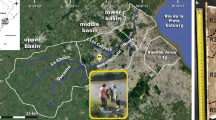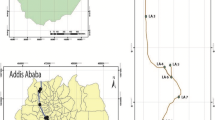Abstract
The Trinity River (Texas, USA) contains in its watershed 23 different reservoir lakes, the largest one being Lake Livingston situated in the lower Trinity River watershed and two potentially polluting metroplexes, Dallas and Houston. In order to determine fluxes of nutrients and trace metals to Galveston Bay, a survey that included 24 discreet samples collected over a year and at various stages of discharge was carried out during 2000–2001. Geochemical (i.e., sorption by Fe oxyhydroxides), biological (i.e., seasonal uptake by sinking algae in Lake Livingston), and hydrological (i.e., dilution effects by increasing flow rates) controls were found to be mainly responsible for variations in dissolved trace metal concentrations rather than pollution sources. The Trinity River loads of suspended sediments and pollutant trace metals entering Galveston Bay at Anahuac were <20% of those reaching Lake Livingston, and only a few percent of the total upstream trace metal load is entering the Gulf of Mexico. Thus, during the transit through the 23 man-made lakes and an estuary, >96% of the pollutant trace metal load is lost to sediments.





Similar content being viewed by others
References
Beale, E.M.L. 1955. On minimizing a convex function subject to linear inequalities. Journal of the Royal Statistical Society (B) 17: 173–184.
Beale, E.M.L. 1959. On quadratic programming. Naval Research Logistics Quarterly 6: 227–243. doi:10.1002/nav.3800060305.
Davison, W. 1993. Iron and manganese in lakes. Earth-Science Reviews 34: 119–163. doi:10.1016/0012-8252(93)90029-7.
Davison, W., and G. Seed. 1983. The kinetics of the oxidation of ferrous iron in synthetic and natural waters. Geochimica Cosmochimica Acta 47: 67–79. doi:10.1016/0016-7037(83)90091-1.
Dong, D., Y.M. Nelson, L.W. Lion, L. Shuler, and W.C. Ghiorse. 2000. Adsorption of Pb and Cd onto metal oxides and organic material in natural surface coatings as determined by selective extractions: new evidence for the importance of Mn and Fe oxides. Water Research 34: 427–436. doi:10.1016/S0043-1354(99)00185-2.
Dong, D., X. Hua, Y. Li, and Z. Li. 2002. Lead adsorption to metal oxides and organic material of freshwater surface coatings determined using a novel selective extraction method. Environmental Pollution 119: 317–321. doi:10.1016/S0269-7491(02)00104-5.
Emerson, S., S. Kalhorn, L. Jacobs, B.M. Tebo, K.H. Nealson, and R.A. Rosson. 1982. Environmental oxidation rate of manganese(II): Bacterial catalysis. Geochimica Cosmochimica Acta 46: 1073–1079. doi:10.1016/0016-7037(82)90060-6.
GBNEP, Galveston Bay National Estuary Program. 1994. The state of the bay. A characterization of the Galveston Bay ecosystem. Galveston Bay National Estuary Program Publication GBNEP-44. 232 pp.
Hung, C.-C., K.W. Warnken, and P.H. Santschi. 2005. A seasonal survey of carbohydrates and uronic acids in the Trinity River, Texas. Organic Geochemistry 36: 463–474. doi:10.1016/j.orggeochem.2004.09.004.
Jiann, K.-T. 1999. Trace metals in Texas rivers: A trace metal speciation study. Ph.D. Dissertation, Texas A&M University, College Station, Texas.
Landing, W.M., and B.L. Lewis 1991. Collection, processing, and analysis of marine particulate and colloidal material for transition metals. In Marine Particles: Analysis and Characterization, pp. 263–272.
Mulholland, P., and C. Olsen. 1992. Marine origin of Savannah River estuary sediments: Evidence from radioactive and stable isotope tracers. Estuarine, Costal and Shelf Science 34: 95–107.
Nelson, Y.M., K.W. Lion, M.L. Shuler, and W.C. Ghiorse. 1999. Lead binding to metal oxide and organic phases of natural aquatic biofilms. Limnology and Oceanography 44: 1715–1729.
Patterson, C.C., and D.M. Settle. 1976. The reduction of orders of magnitude errors in lead analyses of biological materials and natural waters by evaluating and controlling the extent and sources of industrial lead contamination introduction during sample collection and analysis. In Accuracy in trace analysis: sampling, sample handling and analysis. NBS special publication 422, ed. P.D. LaFleur, 321–352. Washington D.C.: National Bureau of Standards.
Phillips, J.D., M.C. Slatter, and Z.A. Musselman. 2004. Dam-to-delta sediment inputs and storage in the lower Trinity River, Texas. Geomorphology 62: 17–34. doi:10.1016/j.geomorph.2004.02.004.
Santschi, P.H. 1995. Seasonality in nutrient concentrations in Galveston Bay. Marine Environmental Research 40: 337–362. doi:10.1016/0141-1136(95)92644-J.
Santschi, P.H., and P.W. Schindler. 1977. Chemical and geochemical studies of Lake Biel. I. A mass balance for Lake Biel and its implications for the rates of erosion in the drainage area. Swiss Journal of Hydrology 39: 181–200.
Shafer, M.M., J.T. Overdier, J.P. Hurley, D. Armstrong, and D. Webb. 1997. The influence of dissolved organic carbon, suspended particulates, and hydrology on the concentration, partitioning and variability of trace metals in two constrasting Wisconsin watersheds (U.S.A.). Chemical Geology 136: 71–97.
Shiller, A.M. 1997. Dissolved trace elements in the Mississippi River: Seasonal, interannual, and decadal variability. Geochimica Cosmochimica Acta 61: 4321–4330. doi:10.1016/S0016-7037(97)00245-7.
Shiller, A.M., and E.A. Boyle. 1987. Variability of dissolved trace metals in the Mississippi River. Geochimica Cosmochimica Acta 51: 3273–3277. doi:10.1016/0016-7037(87)90134-7.
Shiller, A.M., and L. Mao. 2000. Dissolved vanadium in rivers: effects of silicate weathering. Chemical Geology 165: 13–22. doi:10.1016/S0009-2541(99)00160-6.
Stumm, W., and J.J. Morgan. 1996. Aquatic chemistry: Chemical equilibria and rates in natural waters. New York: Wiley.
Tang, D., K.W. Warnken, and P.H. Santschi. 2002. Distribution and partitioning of trace metals (Cd, Cu, Ni, Pb, Zn) in Galveston Bay waters. Marine Chemistry 78: 29–45. doi:10.1016/S0304-4203(02)00007-5.
Tipping, E. 1984. Temperature dependence of Mn(II) oxidation in lakewaters: A test of biological involvement. Geochimica Cosmochimica Acta 55: 3597–3609.
Van Metre, P.C., and E. Callender. 1996. Identifying water-quality trends in the Trinity River, Texas, USA, 1969–1992, using sediment cores from Lake Livingston. Environmental Geology 28: 190–200. doi:10.1007/s002540050093.
Warnken, K.W. 2002. Trace metal inputs to Galveston Bay: Importance of benthic and riverine fluxes. Ph.D. dissertation, Texas A&M University, College Station, TX.
Warnken, K.W., and P.H. Santschi. 2004. Biogeochemical behavior of organic carbon in the lower Trinity River downstream of the Lake Livingston reservoir (Texas, USA). Science of the Total Environment 329: 131–144. doi:10.1016/j.scitotenv.2004.02.017.
Warnken, K.W., G.A. Gill, P.H. Santschi, and L.L. Griffin. 2001. Sediment–water exchange of Mn, Fe, Ni and Zn in Galveston Bay. Texas. Marine Chemistry 73: 215–231. doi:10.1016/S0304-4203(00)00108-0.
Warnken, K.W., P.H. Santschi, K.A. Roberts, and G.A. Gill. 2008. The cycling and oxidation pathways of organic carbon in a shallow estuary along the Texas Gulf Coast. Estuarine, Coastal and Shelf Science 76: 69–84. doi:10.1016/j.ecss.2007.06.010.
Wen, L.-S. 1996. Geochemistry of trace metals in estuarine waters: A multi-phase speciation approach. Ph.D. dissertation, Texas A&M University, College Station, TX.
Wen, L.-S., P.H. Santschi, G.A. Gill, and C. Paternostro. 1999a. Estuarine trace metal distributions in Galveston Bay: Importance of colloidal forms in the speciation of the dissolved phase. Marine Chemistry 63: 185–212. doi:10.1016/S0304-4203(98)00062-0.
Wen, L.S., A. Shiller, P.H. Santschi, and G.A. Gill. 1999b. Trace metal behavior in Gulf of Mexico estuaries. In Biogeochemistry of Gulf of Mexico estuaries, eds. T.S. Bianchi, J.R. Pennock, and R. Twilley, 303–346. New York: Wiley.
Wen, L.-S., Warnken, K.W., and Santschi, P.H. 2008. The role of organic carbon, iron, and aluminium oxyhydroxides as trace metal carriers in the Trinity River and Trinity River Estuary (Galveston Bay, Texas), Marine Chemistry, in revision.
White, W.A., R.A. Morton, and C.W. Holmes. 2002. A comparison of factors controlling sedimentation rates and wetland loss in fluvial-deltaic systems, Texas Gulf coast. Geomorphology 44: 47–66. doi:10.1016/S0169-555X(01)00140-4.
Acknowledgments
This work was funded, in part, by the Harbor Processes Program of the Office of Naval Research (N00014-99-1-0037) and the Texas Institute of Oceanography.
Author information
Authors and Affiliations
Corresponding author
Rights and permissions
About this article
Cite this article
Warnken, K.W., Santschi, P.H. Delivery of Trace Metals (Al, Fe, Mn, V, Co, Ni, Cu, Cd, Ag, Pb) from the Trinity River Watershed Towards the Ocean. Estuaries and Coasts 32, 158–172 (2009). https://doi.org/10.1007/s12237-008-9088-x
Received:
Revised:
Accepted:
Published:
Issue Date:
DOI: https://doi.org/10.1007/s12237-008-9088-x




